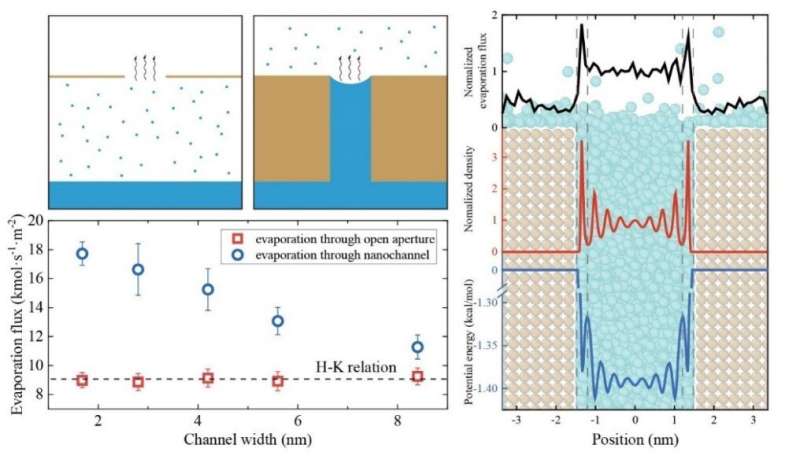Evaporation flux through nanochannels and its micromechanical mechanism. Credit: Fan JingCun et al.
Confined mass transfer mainly focuses on the dynamic behavior of water, ion, gas and other media confined in nanochannels. Scientists recently show increasing interest in confined mass transfer due to its wide application in energy, environment, health and other fields. However, the interface effect is dominant at the nanoscale, and the confined liquid has different structure and transport characteristics from the macro scale. As a result, the traditional continuum mechanics model is no longer applicable, while there is still not a global theoretical model at nanoscale.
Faced with this, the research group led by Prof. WANG Fengchao from Department of Modern Mechanics, University of Science and Technology of China (USTC) of the Chinese Academy of Sciences (CAS), revealed the underlying mechanisms of the enhanced evaporation flux through nanochannels and built a quantitative model of the evaporation-driven liquid flow through nanochannels. This work was published in Physics of Fluids.
The aforementioned work helps explain the ultra-high flux of the covalent organic frameworks (COFs) films in a study proposing a strategy to fabricate membrane distillation membranes composed of vertically aligned channels with a hydrophilicity gradient. This work in a joint effort with USTC and Beijing Institute of Technology were published in Nature Materials.
The enhanced evaporation near the solid–liquid interface and reduced vapor diffusion length in the engineered COF layer work in coordination to increase the water flux of the COF membrane. Besides, it is also found a pure water layer gap between the water–vapor interface and the salt–vapor interface, which prevents direct contact of the ions to the pore walls or the evaporation interface. As the charged surface decreases the adjacent salt concentration and thus alleviates salt crystallization, this leads to the anti-wetting behavior of the engineered COF membranes.
These studies realize superior water desalination and purification performance based on the enhancement of the evaporation through nanochannels compared with traditional technology, promoting the development of gradient membranes for molecular sieving.
More information: Shuang Zhao et al, Hydrophilicity gradient in covalent organic frameworks for membrane distillation, Nature Materials (2021). DOI: 10.1038/s41563-021-01052-w
JingCun Fan et al, Evaporation-driven liquid flow through nanochannels, Physics of Fluids (2020). DOI: 10.1063/1.5137803
Journal information: Nature Materials , Physics of Fluids
Provided by University of Science and Technology of China
























